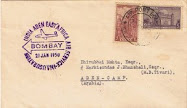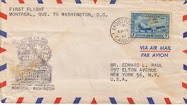The first stamps depicting the Graf Zeppelin were issued by Germany in 1928 showing the airship flying across the Atlantic Ocean. The stamp bears the inscription 'DEUTSCHE LUFTPOST AMERIKA-EUROPA'
The most famous and successful of airships was the LZ 127 Graf Zeppelin which flew for the first time on 18th September 1928. It was named after the pioneer of airships, Ferdinand von Zeppelin, who held the rank of Graf or Count in the German nobility. The great airship flew more than a million miles in the course of 590 flights. The Graf Zeppelin made first commercial passenger flight across the Atlantic in fact she made more than a hundred Atlantic crossings.
In 1929, Graf Zeppelin made a historic Round the World flight of around 21,000 miles which included a non-stop flight from her base in Friedrichschafen, Germany to Tokyo, Japan, which made aviation history. This stage was almost 7000 miles, and aroused intense public enthusiasm around the globe.
The LZ 127 was the largest airship at that time with a total length of 236.6 metres (776 ft) and volume of 105,000 cubic metres (3,700,000 cu ft). It was powered by five Maybach 550 horsepower (410 kW) engines that could burn either Blau gas or gasoline.
The ship achieved a maximum speed of 128 kilometres per hour (80 mph, 70 knots) operating at total maximum thrust of 2,650 horsepower (1,980 kW), which reduced to the normal cruising speed of 117 km/h (73 mph, 63 knots) when running with normal thrust of 2,150 horsepower (1,600 kW. Some flights were made using only Blau gas, for which 12 gas cells were used with a total volume up to 30,000 cubic metres which allowed around 100 hours at cruising speed. At maximum capacity, the fuel tank allowed 67 hours' cruising. Using both gasoline and Blau gas could give 118 hours' cruising.
A spectacular research flight which was a dream of Count Zeppelin was made to the North Pole in July, 1931. This event was philatelically commemorated by overprinting the 1928 set with 'POLAR FAHRT 1931'.
Dr. Eckener planned to fund this expedition by delivering mail post to the ship. An advertising campaign resulted in collection of around fifty thousand pieces of mail from around the world weighing around 300 kgs. Another 120 kgs of mail was carried for the Russian icebreaker Malygin, on which the Italian airshipman and polar explorer Umberto Nobile was a guest. The major cost of the expedition was met solely by sale of postage stamps. The rest of the funding came from Aeroarctic and the Ullstein-Verlag in exchange for exclusive reporting rights.
Mails were stamped with a Special German semi-circular cachet in red depicting the zeppelin passing through the rays of the sun and inscribed on the top 'LUFTSCHIFF GRAF ZEPPELIN' and "POARFAHRT 1931" at the botton
A set of 4 special stamps were issued by Russia on 25th July, 1931 for the polar flight of Graf Zeppelin flight to the North Pole. Stamp shows the Zeppelin flying over an arctic scene with the icebreaker "Malygin" and a polar bear on an ice flow gazing at the graf Zeppelin. Stamps were issued both imperforated & perforated
Card flown from Leningrad
Mails at Leningrad were stamped with a special ornamental postmark "PAR AVION ZEPPELIN" with the date between outline of an airship. A special three lined cachet in red was also applied.
Stamps are from my collection. I wish I had these covers but the scans are from the internet.













3 comments:
Thanks for interesting post. I somewhere posted theme 'airships in philatelia' abaout Russian stamps with airship. If you interested it see THERE.
great post thanks
A very interesting postcard
Post a Comment